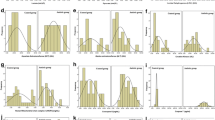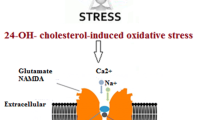Abstract
Autism spectrum disorder (ASD) as a neurodevelopmental disorder is characterized by impairments in social interaction, communication, and restricted, repetitive behavior. Several and reproducible studies have suggested that oxidative stress may represent one of the primary etiological mechanism of ASD that can be targeted for therapeutic intervention. In the present study, multiple regression and combined receiver operating characteristic (ROC) analysis were used to search for a relationship between impaired energy and oxidative metabolic pathways in the etiology of ASD and to find the linear combination that maximizes the partial area under a ROC curve for a pre-identified set of markers related to energy metabolism and oxidative stress. Thirty children with ASD and 30 age and gender matched controls were enrolled in the study. Using either spectrophotometric or ELISA-colorimetric assay, levels of lipid peroxides, vitamin E, vitamin C, glutathione (GSH)/glutathione disulfide (GSSG) together with the enzymatic activity of catalase, plasma glutathione peroxidase (GPx), and blood superoxide dismutase (SOD), were measured in peripheral blood samples, as biomarkers related to oxidative stress. Creatine kinase, ectonucleotidases (ADPase and ATPase) Na+/K+ (ATPase), lactate, inorganic phosphate, and levels of adenosine monophosphate (AMP), adenosine diphosphate (ADP), and adenosine triphosphate (ATP) together with adenylate energy charge, were also measured as markers of impaired energy metabolism. Statistical analysis using ROC curves, multiple and logistic regression were performed. A remarkable increase in the area under the curve for most of the combined markers, representing both energy impaired metabolism or oxidative stress, was observed by using combined ROC analyses. Moreover, higher specificity and sensitivity of the combined markers were also reported. The present study indicated that the measurement of the predictive value of selected biomarkers related to energy metabolism and oxidative stress in children with ASD using ROC analysis should lead to the better identification of the etiological mechanism of ASD associated with metabolism and diet. Agents with activity against the impaired metabolic pathway associated with ASD including the metabolic defects and involved enzymes hold a promise as a novel therapy for ASD.










Similar content being viewed by others
References
Adams JB, Audhya T, McDonough-Means S, Rubin RA, Quig D, Geis E, Gehn E, Loresto M, Mitchell J, Atwood S, Barnhouse S, Lee W (2011) Nutritional and metabolic status of children with autism vs. neurotypical children, and the association with autism severity. Nutr Metab (Lond) 8:34. doi:10.1186/1743-7075-8-34
Al-Gadani Y, El-Ansary A, Attas O, Al-Ayadhi L (2009) Metabolic biomarkers related to oxidative stress and antioxidant status in Saudi autistic children. Clin Biochem 42:1032–1040
Al-Mosalem O, El-Ansary A, Attas O, Al-Ayadhi L (2009) Metabolic biomarkers related to energy metabolism in Saudi autistic children. Clin Biochem 42:949–957
Al-Yafee YA, Al-Ayadhi LY, Haq SH, El-Ansary AK (2011) Novel metabolic biomarkers related to sulfur-dependent detoxification pathways in autistic patients of Saudi Arabia. BMC Neurol 11:139. doi:10.1186/1471-2377-11-139
Atkinson DE, Walton GM (1967) Adenosine triphosphate conservation in metabolic regulation. Rat liver citrate cleavage enzyme. J Biol Chem 242:3239–3241
Ayer A, Tan SX, Grant CM, Meyer AJ, Dawes IW, Perrone GG (2010) The critical role of glutathione in maintenance of the mitochondrial genome. Free Radic Biol Med 49:1956–1968
Bellocchio EE, Reimer RJ, Fremeau RT Jr, Edwards RH (2002) Uptake of glutamate into synaptic vesicles by an inorganic phosphate transporter. Science 289:957–960
Campillo-Gimenez B, Jouini W, Bayat S, Cuggia M (2013) Improving case-based reasoning systems by combining K-nearest neighbour algorithm with logistic regression in the prediction of patients’ registration on the renal transplant waiting list. PLoS One 8:e71991. doi:10.1371/journal.pone.0071991
Chauhan A, Chauhan V (2006) Oxidative stress in autism. Pathophysiology 13:171–181
Chauhan A, Audhya T, Chauhan V (2012) Brain region-specific glutathione redox imbalance in autism. Neurochem Res 37:1681–1689
Chugani DC, Sundram BS, Behen M, Lee ML, Moore GJ (1999) Evidence of altered energy metabolism in autistic children. Prog Neuro-Psychopharmacol Biol Psychiatry 23:635–641
De la Fuente IM, Cortés JM, Valero E, Desroches M, Rodrigues S, Malaina I, Martínez L (2014) On the dynamics of the adenylate energy system: homeorhesis vs homeostasis. PLoS One 9:e108676. doi:10.1371/journal.pone.0108676
Díaz-Hung ML, Yglesias-Rivera A, Hernández-Zimbrón LF, Orozco-Suárez S, Ruiz-Fuentes JL, Díaz-García A, León-Martínez R, Blanco-Lezcano L, Pavón-Fuentes N, Lorigados-Pedre L (2016) Transient glutathione depletion inthe substantia nigra compacta is associated with neuroinflammation in rats. Neuroscience 335:207–220
El-Ansary A (2016) Data of multiple regressions analysis between selected biomarkers related to glutamate excitotoxicity and oxidative stress in Saudi autistic patients. Data Brief 7:111–116
Essa MM, Braidy N, Waly MI, Al-Farsi YM, Al-Sharbati M, Subash S, Amanat A, Al-Shaffaee MA, Guillemin GJ (2013) Impaired antioxidant status and reduced energy metabolism in autistic children. Res Autism Spectr Disord 7:557–565
Frye RE, Delatorre R, Taylor H, Slattery J, Melnyk S, Chowdhury N, James SJ (2013) Redox metabolism abnormalities in autistic children associated with mitochondrial disease. Transl Psychiatry 3:e273. doi:10.1038/tp.2013.51
Fujii E, Mori K, Miyazaki M, Hashimoto T, Harada M, Kagami S (2010) Function of the frontal lobe in autistic individuals: a proton magnetic resonance spectroscopic study. J Med Investig 57:35–44
Ghanizadeh A, Akhondzadeh S, Hormozi M, Makarem A, Abotorabi-Zarchi M, Firoozabadi A (2012) Glutathione-related factors and oxidative stress in autism, a review. Curr Med Chem 19:4000–4005
Giulivi C, Zhang YF, Omanska-Klusek A, Ross-Inta C, Wong S, Hertz-Picciotto I, Tassone F, Pessah IN (2010) Mitochondrial dysfunction in autism. JAMA 304:2389–2396
Gu F, Chauhan V, Chauhan A (2013) Impaired synthesis and antioxidant defense of glutathione in the cerebellum of autistic subjects: alterations in the activities and protein expression of glutathione-related enzymes. Free Radic Biol Med 65:488–496
Hajian-Tilaki K (2013) Receiver operating characteristic (ROC) curve analysis for medical diagnostic test evaluation. Caspian J Intern Med 4:627–635
Hodgson NW, Waly MI, Al-Farsi YM, Al-Sharbati MM, Al-Farsi O, Ali A, Ouhtit A, Zang T, Zhou ZS, Deth RC (2014) Decreased glutathione and elevated hair mercury levels are associated with nutritional deficiency-based autism in Oman. Exp Biol Med (Maywood) 239:697–706
Hoensch H, Morgenstern I, Petereit G, Siepmann M, Peters WH, Roelofs HM, Kirch W (2002) Influence of clinical factors, diet, and drugs on the human upper gastrointestinal glutathione system. Gut 50:235–240
Holmsen H, Robkin L (1977) Hydrogen peroxide lowers ATP levels in platelets without altering without altering adenyalte energy charge and platelet function. J Biol Chem 252:1752–1757
Kim YS, Jang MK, Park CY, Song HJ, Kim JD (2013) Exploring multiple biomarker combination by logistic regression for early screening of ovarian cancer. Int J BioSci BioTechnol 5:67–76
Kowaltowski AJ, Castilho RF, Grijalba MT, Bechara EJ, Vercesi AE (1996) Effect of inorganic phosphate concentration on the nature of inner mitochondrial membrane alterations mediated by Ca2+ ions A proposed model for phosphate-stimulated lipid peroxidation. J Biol Chem 271:2929–2934
Loth E, Spooren W, Ham LM, Isaac MB, Auriche-Benichou C, Banaschewski T, Baron-Cohen S, Broich K, Bölte S, Bourgeron T, Charman T, Collier D, Andres-Trelles F, Durston S, Ecker C, Elferink A, Haberkamp M, Hemmings R, Johnson MH, Jones EJ, Khwaja OS, Lenton S, Mason L, Mantua V, Meyer-Lindenberg A et al (2016) Identification and validation of biomarkers for autism spectrum disorders. Nat Rev Drug Discov 15:70–73. doi:10.1038/nrd.2015.7
Minshew NJ, Goldstein G, Dombrowski SM, Panchalingam K, Pettegrew JW (1993) A preliminary 31P MRS study of autism: evidence for under synthesis and increased degradation of brain membranes. Biol Psychiatry 33:762–773
Mischley LK, Conley KE, Shankland EG, Kavanagh TJ, Rosenfeld ME, Duda JE, White CC, Wilbur TK, De La Torre PU, Padowski JM (2016) Central nervous system uptake of intranasal glutathione in Parkinson’s disease. NPJ Parkinsons Dis 2:16002. doi:10.1038/npjparkd.2016.2
Naviaux JC, Schuchbauer MA, Li K, Wang L, Risbrough VB, Powell SB, Naviaux RK (2014) Reversal of autismlike behaviors and metabolism in adult mice with single-dose antipurinergic therapy. Transl Psychiatry 4:e400. doi:10.1038/tp.2014.33
Nissenkorn A, Zeharia A, Lev D, Fatal Valevski A, Barash V, Gutman A, Harel S, Lerman-Sagie T (1999) Multiple presentations of mitochondrial disorders. Arch Dis Child 81:209–214
Pellerin L, Magistretti PJ (1997) Glutamate uptake stimulates Na+/K+ ATPase activity in astrocytes via activation of a distinct subunit highly sensitive to ouabain. J Neurochem 69:2132–2137
Poling JS, Frye RE, Shoffner J, Zimmerman AW (2006) Developmental regression and mitochondrial dysfunction in a child with autism. J Child Neurol 21:170–172
Qasem H, Al-Ayadhi L, El-Ansary A (2016) Cysteinyl leukotriene correlated with 8-isoprostane levels as predictive biomarkers for sensory dysfunction in autism. Lipids Health Dis 15:130. doi:10.1186/s12944-016-0298-0
Raimundo N (2014) Mitochondrial pathology: stress signals from the energy factory. Trends Mol Med 20:282–292. doi:10.1016/j.molmed.2014.01.005
Rose S, Melnyk S, Pavliv O, Bai S, Nick TG, Frye RE, James SJ (2012) Evidence of oxidative damage and inflammation associated with low glutathione redox status in the autism brain. Transl Psychiatry 2:e134. doi:10.1038/tp.2012.61
Rossignol DA, Frye RE (2012) Mitochondrial dysfunction in autism spectrum disorders: a systematic review and metaanalysis. Mol Psychiatry 17:290–314
Rutter M, Le Couteur A, Lord C, Faggioli R (2005) ADI-R: autism diagnostic interview—revised: manual. Giunti O.S. Organizzazioni Speciali, Florence
Rutter M, DiLavore PC, Risi S, Gotham K, Bishop SL (2012) Autism diagnostic observation schedule: ADOS-2. Western Psychological Services, Los Angeles
Sherer TB, Betarbet R, Stout AK, Lund S, Baptista M, Panov AV, Cookson MR, Greenamyre JT (2002) An in vitro model of Parkinson's disease: linking mitochondrial impairment to altered alpha-synuclein metabolism and oxidative damage. J Neurosci 22:7006–7015
Sies H (2014) Role of metabolic H2O2 generation: redox signaling and oxidative stress. J Biol Chem 289:8735–8741. doi:10.1074/jbc.R113.544635
Skuse D, Warrington R, Bishop D, Chowdhury U, Lau J, Mandy W, Place M (2004) The developmental, dimensional and diagnostic interview (3di): a novel computerized assessment for autism spectrum disorders. J Am Acad Child Adolesc Psychiatry 43:548–558
Smith BA, Smith BD (2012) Biomarkers and molecular probes for cell death imaging and targeted therapeutics. Bioconjug Chem 23:1989–2006
Takamori S, Rhee JS, Rosenmund C, Jahn R (2000) Identification of a vesicular glutamate transporter that defines a glutamatergic phenotype in neurons. Nature 407:189–194
Theoharides TC (2013) Extracellular mitochondrial ATP, suramin, and autism? Clin Ther 35:1454–1456
Van Stralen KJ, Stel VS, Reitsma JB, Dekker FW, Zoccali C, Jager KJ (2009) Diagnostic methods I: sensitivity, specificity, and other measures of accuracy. Kidney Int 75:1257–1263
WMA - World Medical Association (2013) World Medical Association Declaration of Helsinki: ethical principles for medical research involving human subjects. JAMA 310:2191–2194. doi:10.1001/jama.2013.281053
Wink LK, Adams R, Wang Z, Klaunig JE, Plawecki MH, Posey DJ, McDougle CJ, Erickson CA (2016) A randomized placebo-controlled pilot study of N-acetylcysteine in youth with autism spectrum disorder. Mol Autism 7:26. doi:10.1186/s13229-016-0088-6
Yoboue ED, Augier E, Galinier A, Blancard C, Pinson B, Casteilla L, Rigoulet M, Devin A (2012) cAMP-induced mitochondrial compartment biogenesis: role of glutathione redox state. J Biol Chem 287:14569–14578. doi:10.1074/jbc.M111.302786
Acknowledgements
The authors extend their appreciation to the Deanship of Scientific Research at King Saud University for funding the work through the research group project No (RGP-VPP-005).
Author information
Authors and Affiliations
Corresponding author
Ethics declarations
Conflict of interest
The authors declare no potential conflicts of interest with respect to the authorship, and/or publication of this article.
Ethical approval
All procedures performed were in accordance with the ethical standards of the institutional and/or national research committee, and with the 1964 Helsinki declaration and its later amendments or comparable ethical standards.
Rights and permissions
About this article
Cite this article
El-Ansary, A., Bjørklund, G., Chirumbolo, S. et al. Predictive value of selected biomarkers related to metabolism and oxidative stress in children with autism spectrum disorder. Metab Brain Dis 32, 1209–1221 (2017). https://doi.org/10.1007/s11011-017-0029-x
Received:
Accepted:
Published:
Issue Date:
DOI: https://doi.org/10.1007/s11011-017-0029-x




